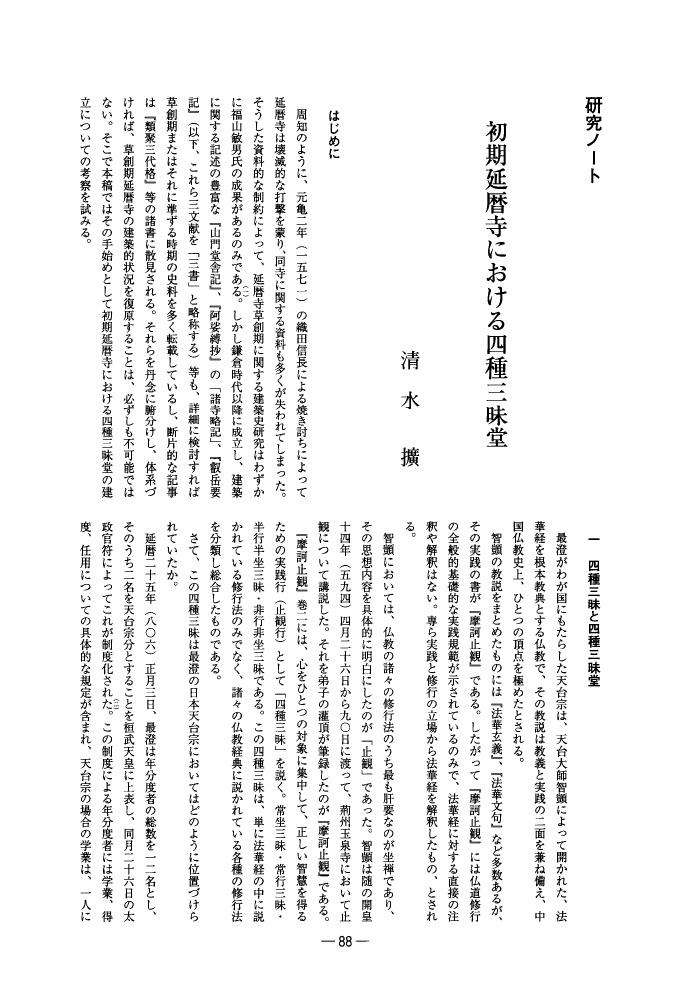3 0 0 0 OA 墓所堂としての仏堂建築 : 平安貴族の葬法と建築(下)
- 著者
- 清水 擴
- 出版者
- 一般社団法人 日本建築学会
- 雑誌
- 日本建築学会計画系論文報告集 (ISSN:09108017)
- 巻号頁・発行日
- vol.402, pp.127-136, 1989-08-30 (Released:2017-12-25)
In 1005, Fujiwara Michinaga constructed the Jomyoii temple, where the Hokkedo was the main hall. Taking this oppotunity,the relation between Hokkedo and dead body developped gradually. Late in the 12th century, it got firmly fixed to use Hokkedo as the mausoleum of emperors. And in Kamakura era, this formality became popular among the leaders of the "samurai". On the other hand, the Amidados used as mausplems were few. We can understand this fact as follows. The interior of the Amidado was recognised to be very pure, so it might be hesitated to enshrine the dead body in it which bore much "Kegare" (impurity).
2 0 0 0 OA 平安時代阿弥陀堂の堂内荘厳とその系譜
- 著者
- 清水 擴
- 出版者
- 一般社団法人 日本建築学会
- 雑誌
- 日本建築学会計画系論文報告集 (ISSN:09108017)
- 巻号頁・発行日
- vol.389, pp.136-142, 1988-07-30 (Released:2017-12-25)
The purpose of this paper is to make clear the genealogy of the interior decoration of "Amidado" in Heian era. The conclusions are as follows. (1) The sourse of the interior decoration of "Amidado" exists in halls of Hojoji temple. (2) The method of interior decoration was completed in Hoodo, and the other "Amidado" took Hoodo for a model. (3) "Kuhon-ojo-zu" and "Gokuraku-jodo-zu" were the main themes of the interior painting, and several "Hiten", sculpture or painting, were arranged of the upper walls. (4) The first example of the use of "Raden" (mother-of-pearl-work) existed in "Amidado" of Hojoji, and of "Makie" (lacquer) in Tohokuin of Hojoji. (5) Introduction of the painting of "Ryokai-mandara" on the columns is due to belief in "Komyo shingon".
2 0 0 0 九体堂と一間四面堂 : 平安浄土教建築についての序論・その 2
- 著者
- 清水 擴
- 出版者
- 一般社団法人日本建築学会
- 雑誌
- 日本建築学会論文報告集 (ISSN:03871185)
- 巻号頁・発行日
- no.207, pp.51-56, 73, 1973-05-30
- 被引用文献数
- 1
From the eleventh century to the twelfth, many Amidados were built. More than half of them were three-bay-square halls. Few buildings of this type had been built by this time. What is the reason for the rapid increase in their construction? There are two reasons : the first and major one is that it was the smallest hall with a formal style; and the other and less important reason is that it coincided with the form of the Jogyodo, a hall which was formerly thought to be the prototype of the Amidado. In order to go to Jodo, a Buddhist heaven, after one's death, it is necessary to perform pious acts. For example, an aristocrat should build a Buddhist hall. The three-bay-square hall was the easiest type to build since it was the smallest hall with a formal style.
2 0 0 0 「常行堂と阿弥陀堂」 : 平安浄土教建築についての序論・その 1
- 著者
- 清水 擴
- 出版者
- 一般社団法人日本建築学会
- 雑誌
- 日本建築学会論文報告集 (ISSN:03871185)
- 巻号頁・発行日
- no.206, pp.75-81, 86, 1973-04-30
The origin of the Amidado (a hall for worship of Amida) is usually attributed to the Jogyodo. But I think these have different sources. If we compare the figures enshrined in the two halls and the form of the two plans, we can observe distinct differences. The Jogyodo always belonged to the temple, and was the place where public events were held, while the Amidado was the place for private prayer. In proportion to the increase of the believers of the Jodokyo, a new form of belief was born and in accordance with it, a new form of architecture was invented. This was the Amidado.
2 0 0 0 法華堂について : 平安浄土教建築についての序論・その3
- 著者
- 清水 擴
- 出版者
- 一般社団法人日本建築学会
- 雑誌
- 日本建築学会論文報告集 (ISSN:03871185)
- 巻号頁・発行日
- no.208, pp.77-83, 89, 1973-06-30
The Hokkedo has not been thought to belong to Jodokyo architecture. But people had to repent of their sins in order to go to Jodo. The Hokkedo was very closely related to the Jodokyo since it was a place for penance. Goshirakawa, the retired emperor, seems to have been the first to use the Hokkedo as one's mausoleum. He gave different functions to Hokkedo and Sembodo, which had been originally the same thing; the former, as one's mausoleum, the latter, as a place for penance. The reason for this was due to his enthusiastic belief in the Hokkekyo, while he did not give credence to the dogma of the Jodokyo.
1 0 0 0 OA 初期延暦寺における四種三昧堂
- 著者
- 清水 擴
- 出版者
- 建築史学会
- 雑誌
- 建築史学 (ISSN:02892839)
- 巻号頁・発行日
- vol.42, pp.88-96, 2004 (Released:2018-06-28)
1 0 0 0 OA 法華堂について : 平安浄土教建築についての序論・その3
- 著者
- 清水 擴
- 出版者
- 一般社団法人 日本建築学会
- 雑誌
- 日本建築学会論文報告集 (ISSN:03871185)
- 巻号頁・発行日
- vol.208, pp.77-83,89, 1973-06-30 (Released:2017-08-22)
The Hokkedo has not been thought to belong to Jodokyo architecture. But people had to repent of their sins in order to go to Jodo. The Hokkedo was very closely related to the Jodokyo since it was a place for penance. Goshirakawa, the retired emperor, seems to have been the first to use the Hokkedo as one's mausoleum. He gave different functions to Hokkedo and Sembodo, which had been originally the same thing; the former, as one's mausoleum, the latter, as a place for penance. The reason for this was due to his enthusiastic belief in the Hokkekyo, while he did not give credence to the dogma of the Jodokyo.
